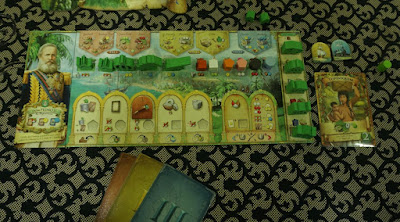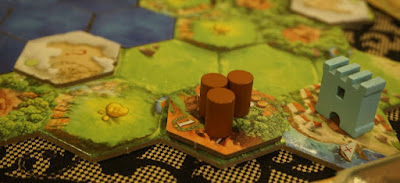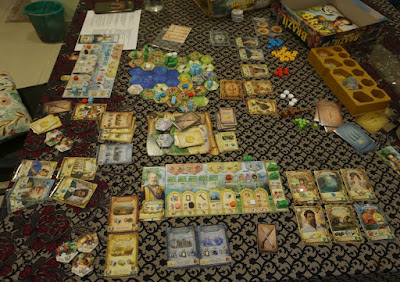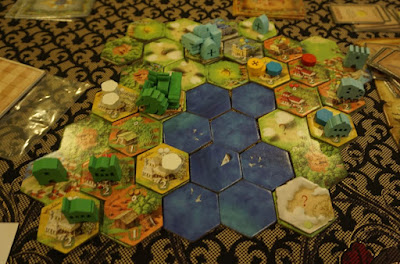The Game
Brazil Imperial is a game of colonisation and nation building set in
the age of exploration. It is a 4X game and a civilisation game in which you
start with a humble capital and grow into an empire, competing with other
players for territory and resources. You construct buildings and cities. You
produce resources and use them to expand your empire. You discover unknown
secrets of the land. You raise troops and conduct battle to seize opponent
cities, buildings and resources. The game is played over three eras. Every
player gets one mission card per era. An era progresses to the next the first
time anyone completes a mission of that era. Once anyone completes a mission
of the third era, the game ends. Many things you do in the game give you
points. The highest scorer at the end of the game wins.
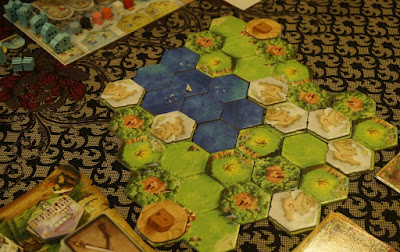
The game comes with many different setups. This above is one of the 2-player
setups. The starting locations of the two capitals are fixed. The fog tiles
are secrets you get to explore. They are usually good and the benefits are
claimed on a first come first served basis. The map has different terrain
types - plains, forests, gold deposits and lakes. Different terrain types
allow different buildings.
Everyone gets a player board like this. The large tile on the left is a
monarch tile. You have a few options and every monarch gives a different
bonus. The player board is mostly identical between players. The only
differences are the army composition and costs. Each different coloured player
board comes with a set of monarchs.
The green player has two archers, a monarch, a cavalry and a cannon. The icons
below the units are the costs to raise these troops. The units have different
combat strengths and are also worth victory points the moment you create them.
They never die. If they lose a battle, they just go to a waiting area. The
next time you perform the deploy action, you may deploy them to your city or
capital for free.
The monarch unit is the only unit type which can establish a new city. The
cavalry unit brings along any number of other units when it moves, which is
very handy. The cannon can initiate a battle from an adjacent space. Normally
you need to enter a space occupied by an opponent to initiate battle.
A player turn is short and simple. You pick one action, and you march once
or twice. You can always march a unit once. Whether you get a second march
depends on the action you pick and what kind of extra march it gives. E.g.
the buy painting action gives an extra march if a unit is going to march
into an adjacent forest. So it's situational.
The 7 action options are shown in arches on the player board (see above).
You can deploy troops, buy paintings, construct buildings and cities,
collect resources and convert resources. Paintings give you special
abilities and are worth points. They augment your abilities and are good
investments. There's one action called manufacturing. You spend resources to
move a cube, a pentagon or an octagon (see above) to one of the action
arches. This enhances the action designated by the arch, e.g. waiving the
payment for producing goods. This is also good investment especially when
you enhance an action you plan to perform many times.
There are three types of paintings and two of each type will be made
available at all times. The rightmost two are free, the others require
payment. The leftmost two are the most expensive because you need to pay
science. The blue resources are science, the most precious resource in the
game.
These are mission cards. They are what drive the core progression of the
game. Think of them as a countdown mechanism. Whenever a mission of a
particular era is completed and announced, everyone progresses to the next
era. You must work on your missions so that you don't miss out on the point
value and also the reward of building a palace. There are 6 types of palaces
in the game. The first one is free and is used to mark your capital. The
rest can be built only when you complete missions. They give various
bonuses, and often these come in the form of extra victory points based on
specific criteria being met at game end. Your choice of palace determines
how you play.

These are the palaces you get to build during play.
When you construct a building, it immediately produces resources. You place
the resources on the building itself and you can use them any time. Once you
exhaust them, you can make the building produce again by picking the renovate
action. It's called renovate and not produce because before you produce, you
may flip the building to the other side, transforming it into another building
type which produces a different resource type.
This little side board is for organising some of the components. At the top
left you have the combat cards. You draw a combat card when you deploy a unit.
Combat cards give you extra combat strength. During combat, the strength of
units, buildings and cities are open information. The strength of combat cards
is hidden information. Both combatants commit combat cards face-down. They are
revealed when combat resolution is done.
At the top right you have the gold cards. They have various abilities. Some
may score you points at game end based on certain conditions being met. Some
give one-time powers. If a gold card is not useful to you, you can simply
spend it as a gold coin.
The two stacks at the bottom are city tiles. When you build a city, you must
pick from the top of one of these stacks. Cities are worth 5VP each, which is
a lot. They are also expensive to build.
Brazil Imperial is a game where you race to grow your nation, producing
more resources which you then spend to construct more buildings and cities.
Almost every other thing you do in the game scores you points - buildings,
cities, military units, paintings and so on. Whoever does the best overall job
of building his empire will be the ultimate winner.
The Play
I did a 2-player game with Allen, so our map was small. We were both new to
the game.
Allen (light blue) picked the capital location at the bottom right, so I took
the other one at the top left. One thing unique about the light blue empire is
most military units are built with gold coins, so Allen focused on
constructing buildings which produced gold coins. A new building can only be
constructed next to a capital, a city or another building. Only new cities can
be constructed without being adjacent to your territory.
The mission of the first era was not very difficult and I completed it
quickly. I had a strict focus and minimised the number of steps needed to
complete the mission. The speed surprised Allen a little. However for both
Eras 2 and 3 he beat me to the missions.
This piece in the middle is Allen's monarch. The monarch is a military unit
and has combat strength. Its most important function is to build new
cities.
My (green) monarch was now deployed too and sailed towards the group of
unexplored territories (fog tiles). Allen and I competed to uncover the
secrets of these unexplored territories. He was faster than me in building
construction. By now he had five buildings while I had only three.
When you perform an action, you place your action marker inside the
corresponding arch. This reminds you not to perform the same action next
turn. You use a different action marker every era. When an era ends, you
flip over the expired action marker and place it below one of your action
arches. This boosts the action from then on. In the photo above you can tell
this is the third era, because two action arches now have been boosted, with
old action markers placed below them.
My monarch tile (on the left of the player board) gave me resources when I
purchased paintings. I picked this particular monarch because one of my
missions required collecting many paintings. I wanted to create synergy.
At the top right Allen and I were now in a stalemate situation. We had both
built cities, and now we both had armies stationed in our cities. No one
dared to attack, because whoever attacked would be at a disadvantage. The
defender could rely on the combat strength of his city. Fighting never broke
out between these two cities until the end of the game.
The map doesn't take up much space, but the rest of the game
does.
One of my (green) palaces scored points based on the number of cotton farms
I had, so I build as many cotton farms as I could, and also renovated
foundries to become cotton farms. The white resources on the map are
cotton.
When we did the final scoring, Allen and I both scored 76! I fell behind Allen
in expanding my empire so I was not optimistic. I was the one who read the
rules and I was more familiar with some of the intricacies. That gave me some
advantage in some detailed execution aspects. The tiebreaker was science (blue
resource) on the map. Allen had two and I had none, so he was the victor. I
wasn't able to start constructing Era 3 buildings, and he already had
two.
The Thoughts
A turn in Brazil Imperial is very simple, and it makes the game feel
accessible. You only perform one action and you may march up to twice. Down
time between player turns is minimal. You always feel engaged. Actions are
simple, and you usually have to plan a few steps ahead to complete a certain
objective, e.g. renovate a certain building to produce resources, then spend
those resources on manufacturing a product to enhance the deploy action, and
then perform the deploy action to be able to deploy two units at once.
You are always in a cycle of producing resources then spending them to expand
your empire, be it in enhancing your abilities or building more and more stuff
- buildings, military units and cities. You are always hungry and growing.
That said, being big does not guarantee victory. You may have more space to
construct cities and buildings, but smaller empires which are efficient in
utilising their buildings can still do well in scoring points.
There is a delicious tension between upgrading your abilities and racing to
complete missions. On one hand it seems a no-brainer to upgrade your abilities
in the early game, so that you get to enjoy the advantages for the rest of the
game. But how far should you go? There is time pressure in completing the
missions. If you spend too much time on upgrading many different abilities,
you may not be utilising all of them enough. You may fall behind your
opponents. Yet if you only focus on the race without developing a competitive
edge, you will likely be outpaced by your opponents. There is pressure to grab
land and to explore the unknown territories too. Finders keepers
(usually)!
Brazil Imperial is the type of game with many different ways to score
points. Sometimes when playing such games I feel my strategic planning doesn't
matter much. No matter what you do, you will score points. It's just a matter
of being efficient and being clever with tactical execution. As long as you
are efficient, you will end up scoring more points than your opponents. You
try to be lazy. You want maximum gains with minimum effort. It comes down to
an efficiency game. This is something that nags at me when I play.
I like that the game makes me feel that there are many things I want to do,
and I have a tough time deciding which I should do first, and which I may have
to give up. You can't take your sweet time and do everything you like. There's
a race going on. You need to pick a few areas and make sure your actions
synergise well. Brazil Imperial is a development game. It is fulfilling
to see your empire grow. You progress to construct better and better
buildings. You accumulate wealth. You push your borders outwards. There is
some combat but it won't be your primary focus. Raising troops gets you
victory points, but killing opponents' soldiers doesn't. It takes much effort
to capture your opponents' cities and buildings. It may not be worthwhile. The
military aspect is an arms race. You can't afford to fall behind too far
because your opponents are still threatening to steal your resources and
points. You may not want to spend too much effort on planning an offensive
because you may not get much out of it. It's not too hard to play defense and
to match an aggressive neighbour in strength.
The production of the game is top-notch, from the art to the game components.
Allen said he decided to buy it because of how pretty it was, and that was
before he even read the rules.
I like how Brazil Imperial maintains a sense of urgency. You don't know
your opponents' missions and how close they are to completing them. The clock
is ticking and you always worry about falling behind and being unable to
complete your own missions. Era 3 missions are broad and thus not easy to
fulfil. You are often torn between focusing only on the main missions and
going off on lucrative side quests. You want to do everything, and you are
constantly worried you won't have enough time.













